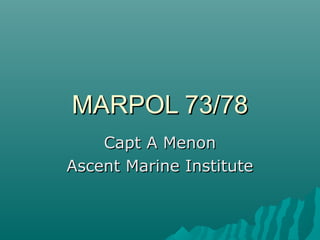This document summarizes the key provisions of MARPOL 73/78, the main international convention covering prevention of pollution of the marine environment by ships. It outlines the six annexes of MARPOL which cover pollution by oil, noxious liquid substances, harmful substances carried by sea in packaged form, sewage, garbage, and air pollution. For each annex, it provides details on entry into force date, prohibited discharge criteria, record keeping and equipment requirements such as oil filtering and sewage treatment systems.































